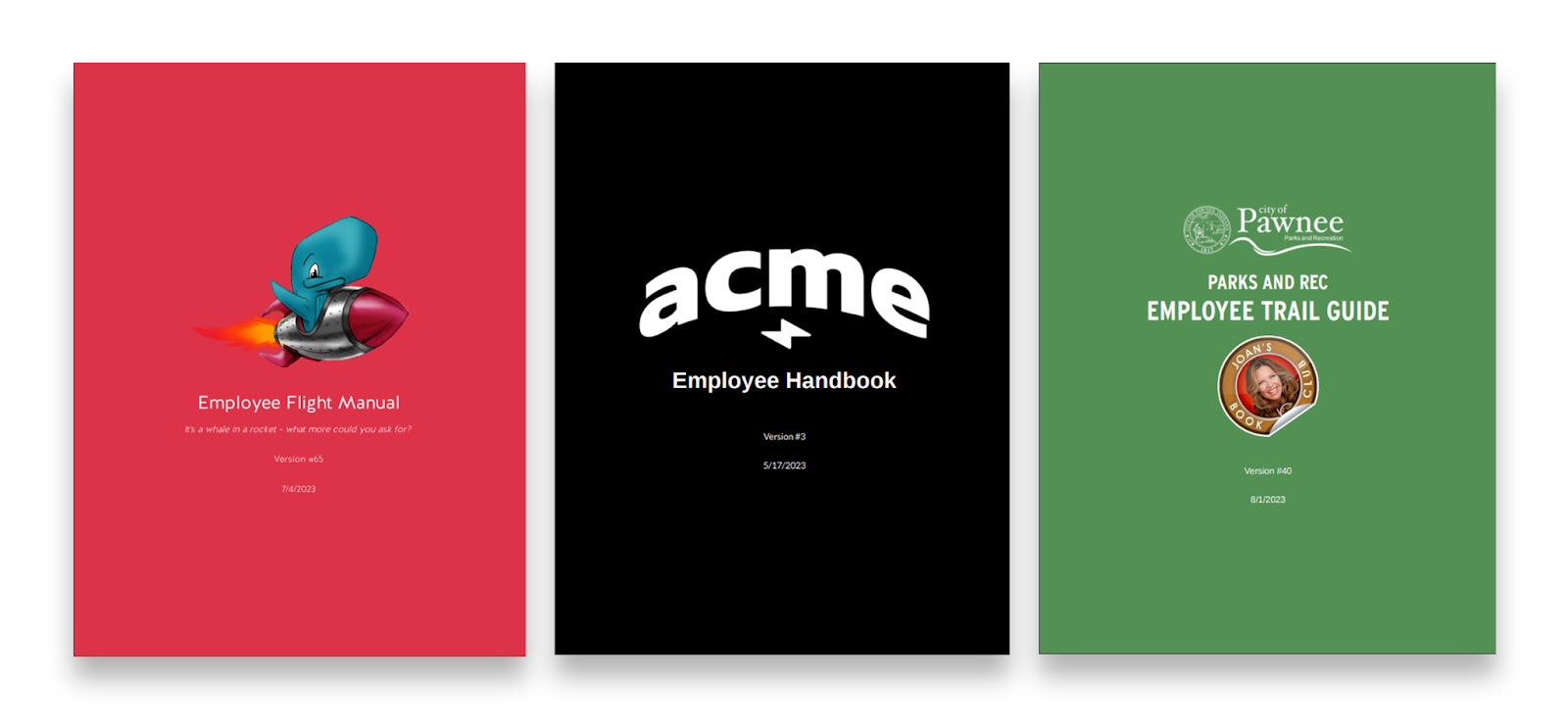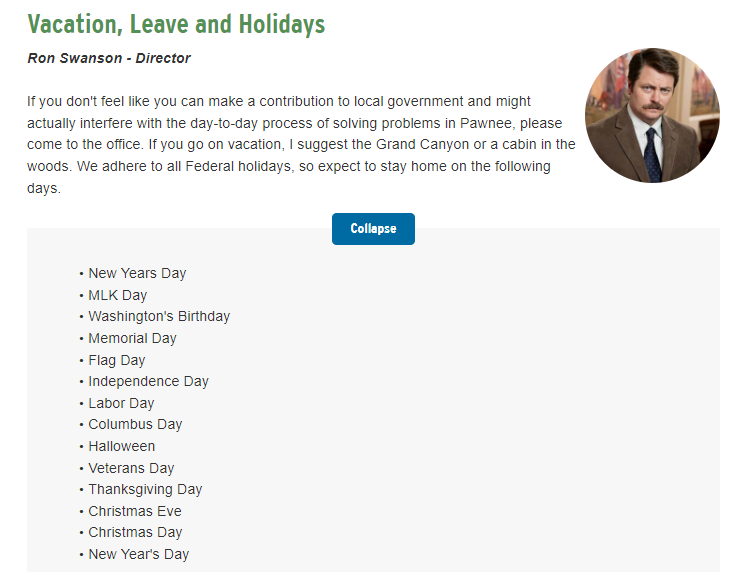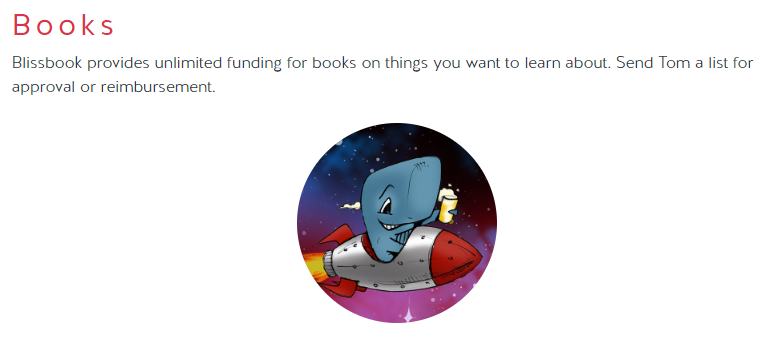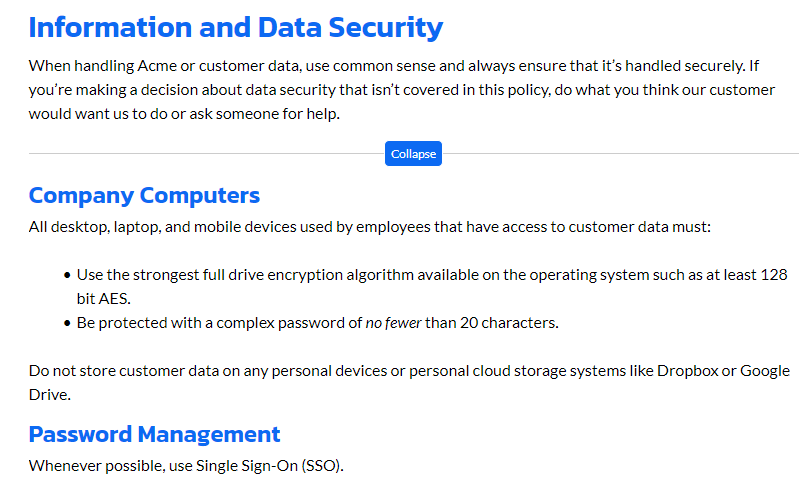What Policies Should Be Included in an Employee Handbook
Your employee handbook serves as a guide for both new and existing employees, helping them navigate the company with ease. Creating an employee handbook may seem overwhelming at first, but we promise it’s worth the investment.
To make your life easier, we’ve outlined the policies you should include in your employee handbook.
Understanding the Employee Handbook
Your employee handbook should tell employees everything they need to know about working at the company. It’s different from a policy manual, which is geared toward the people who enforce policies within your organization.

Employee handbooks include everything from the company’s mission and values to necessary information about leaves and compensation. Handbooks also help organizations ensure compliance with state and federal laws.
Since your handbook covers a lot of content, the creation process can be time-consuming, but it’s worth the effort. Without a handbook, your organization may be inefficient, have dissatisfied employees, and be vulnerable to employee claims. If you need a cheat code to speed along the progress, let us know. We can provide multi-state model policies for your team to review, and can then import and design your handbook to get you ready to launch.
By creating a strong employee handbook, you promote fairness and reduce conflict — and you also mitigate legal risk.
Let’s take a look at the fundamental policies to include in every employee handbook. If you’re creating your first handbook, you’ll probably want to check out our How to Write Policies & Procedures guide.
Policies about Creating a Welcoming, Safe Workplace
In this part of the handbook, you should focus on how you make your workplace welcoming for all types of people. At a minimum, you’ll want to include the following policies.
At-Will Employment Policy
Though not the most exciting part of your employee handbook, your at-will employment policy should be front and center. If you’re an at-will employer, employees need to know that either party — them or you — is free to terminate the employment relationship at any time, assuming the reason isn’t illegal.
You can start this policy off in a friendly manner by saying something like, “We want you to enjoy your employment here, and a big part of that is making sure it’s a good fit for both of us.” Then dive into the details.
Equal Employment Opportunity / Non-Discrimination Policy
Begin this section by introducing your equal employment opportunity policy. This policy details your company’s commitment to providing fair and equal treatment to all employees and job applicants. The primary goal is to ensure that individuals are treated fairly and are not subject to discrimination or bias based on characteristics such as race, color, religion, sex, national origin, age, disability, or other protected categories. Most EEO policies include a non-discrimination statement, which further emphasizes this promise.
You’ll also want to communicate your commitment to providing reasonable accommodations for individuals with disabilities. You should convey your willingness to accommodate people with different needs and how to request an accommodation. This fosters inclusivity and ensures every team member has an equal opportunity to succeed.
Anti-Harassment and Bullying Policies
To create a pleasant work atmosphere, you’ll want to communicate that all types of harassment, including sexual harassment and bullying, are prohibited. After explaining your zero-tolerance approach to harassment and bullying, you should let employees know how to raise concerns. How do they report policy violations? And how does your company uniformly handle complaints of harassment and/or bullying?

Workplace Health, Safety, and Violence Policies
In addition to addressing harassment and bullying, it’s important to ensure your employees feel safe at work. You can do this by highlighting how you (1) promote physical safety and (2) prohibit violence of any kind. Here, you may cover things like safety procedures and equipment, emergency protocols, and weapons in the workplace.
Policies about a Drug, Alcohol, and Smoke-Free Workplace
This section should also include your policies on drugs, alcohol, and smoking. You’ll want to emphasize that the intent of these policies is to keep everyone safe and healthy. As discussed in Blissbook’s free eBook, How to Write a Culture-First Employee Handbook, it’s always good to explain the reason behind your policies — especially when it comes to potentially sensitive topics.
Time Off and Leaves
No matter how much fun your workplace is, your employees will want to know about time off work and leaves of absence. Here are some of the policies you’ll want to include in this section of your handbook.
Company Holidays and Paid Time-Off (PTO)
This policy tells your employees how much time off they’ll get and how they’ll earn it. You’ll also want to explain how to request time off and how it gets approved. List which company holidays you celebrate and the pay practices surrounding holidays, including working on holidays.

Sick Leave and Family and Medical Leave Act (FMLA)
If you have a sick leave policy that’s separate from your PTO policy, you’ll want to detail that here. It’s important to note that many states have sick leave requirements, so consult with your legal counsel to be sure you’re in compliance with the laws that apply to you. Need state-specific model policies to start with? Contact us.
If your company meets the eligibility requirements for the Family and Medical Leave Act (FMLA), you’ll also want to tell workers about their rights to take time away from work for certain family or health issues.
Other Leaves of Absence
Be sure to communicate the various types of leave available to your employees, like time off for military service, jury duty, and voting. Other types of leave include parental leave to welcome a new child, bereavement leave, and workers’ compensation.
Your company geography and size may require additional leaves — like domestic violence leave or emergency responder leave — so it’s wise to get legal advice on which leaves you need to include in your handbook. And, if you’ve got employees in many states, you might want to check out our article, 4 Best Multi-State Employee Handbook Software Platforms.
Benefits and Compensation
Your employees will be eager to learn about company benefits and other compensation-related matters. Here are the must-have policies related to these topics.
Benefits
Your handbook should include basic information about the benefits you offer and who’s eligible for them. It’s good practice to provide a high-level overview of the benefits, then encourage employees to review plan summaries for additional detail.
Here, you’ll want to cover traditional insurance benefits, like medical, dental, and vision coverage. This is also where you’ll tell employees about things like retirement plans, short and long-term disability, and life insurance.
Be sure to include any other perks unique to your business — be it transportation benefits, employee discounts, or educational opportunities. Or books!

Pay-Related Policies
Of course employees want to know about getting paid! This is where you’ll want to dive into employee classifications, such as full-time or part-time, and exempt or non-exempt (in accordance with the Fair Labor Standards Act). Discuss topics like work hours, timekeeping procedures, overtime, meal and rest breaks, and payday.
Attendance and Punctuality
While you’re talking about things like timekeeping and pay, you’ll want to communicate your policies and procedures surrounding attendance and punctuality. Employees should know what’s expected of them and how to report late arrivals or absences.
Work Performance and Job Opportunities
This section of your handbook should house your policies about performance evaluations and job postings, transfers, and promotions. It’s important to outline how employees will receive feedback and how they can apply for other roles within the company. And, while you’re talking about performance, you should convey your policy on progressive discipline.
Office Life and Business Conduct
It can be easy to get caught up in the policies geared toward legal compliance, but it’s important to explain what you expect of employees each day. These matters range from general office expectations to other, more serious items, like how to avoid conflicts of interest. You’ll want to consider the following items when developing this portion of your employee handbook.
Day-to-Day Office Life Policies
Don’t forget to talk about practical daily life at the office. For example, include any policies you have regarding dress code, office closures, and solicitation / distribution. This is also a good place to discuss your policy on remote work / telecommuting — the nontraditional “office.”
Highlight your open door policy, which empowers employees to raise concerns. Another good policy to include is the one that describes how employees should handle publicity and media inquiries. Your marketing department will thank you!
Think about your specific organization and any general policies you have in place to make your workforce operate at their best.
Policies about Business Conduct
No matter your company size or industry, it’s crucial to convey conduct expectations. Your code of conduct should detail expectations about appropriate employee behavior, professional conduct, and other ethical matters. It’s helpful to provide a list of sample violations, but you should also include language that states the list isn’t all-encompassing and that you reserve the right to make decisions on a case-by-case basis.
Also include policies about conflicts of interest, outside employment, and handling confidential information. Depending on your industry or the nature of your work, you may include additional policies, like the Health Insurance Portability and Accountability Act (HIPAA) or procedures related to food safety and hygiene. If you’ve got a policy about employment of relatives or significant others, include that here.
You’ll also want to touch on employee privacy matters, such as those related to personnel files, reference checks, and employment verification.
Generally speaking, consider what behaviors could harm your brand reputation, and include any policies related to that.
Technology and Communications Policies
It’s important to remind employees that technology and communications systems should be used primarily for business purposes. Is it okay to periodically surf the web at work? What about using the office WiFi to stream music? When it comes to using technology, it’s important to clarify things like acceptable use of company systems, data security, and social media expectations.

Separation Procedures
In the last sections of your employee handbook — or one of the last — it’s wise to cover any procedures you have related to separation of employment. This may include the various kinds of separation, like resignation, retirement, and termination, and how each one should be handled. You can also include other transition-related information, like exit interviews, returning company property, and COBRA.
Be sure to tell employees how and when they’ll receive their final paycheck — and keep in mind this may vary depending on the location. As always, consult with an attorney to be sure the information you’re providing is accurate.
Don’t Forget Your Acknowledgement Page
Make sure to top off your employee handbook with a page where employees can acknowledge receipt. This helps you keep track of who has received your handbook, and it’s beneficial in the case of misunderstandings or legal disputes.

Final Thoughts
Although you can find many employee handbook templates online, you’ll need a document tailored to your organization’s needs. At Blissbook, we can help customize your employee handbook depending on your business needs, size, and location(s). You’ll also want to update your handbook at regular intervals, which we can assist with, too.
When employees have a clear understanding of the company, their rights, and how to go about their day-to-day work lives, they’ll generally perform better. At the same time, a carefully developed handbook reduces conflicts and keeps you protected.
Blissbook’s digital handbook platform enables you to stay on brand while creating an authentic, effective employee handbook. You’ll be a step ahead of the rest by making your handbook interactive, customized to multiple devices, and easy to update and distribute.
No matter where you are in your handbook journey, you can set up a free trial with Blissbook to create, design, or update your handbook today!